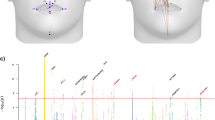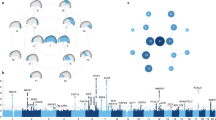Abstract
Quantitative trait loci (QTL) mapping analysis was performed for the mandible morphology in DDD.Cg-\(A^{y}/\hbox {Sgn}\) and C57BL/6J inbred mice. The size and shape of the mandible was analysed by landmark-based geometric morphometrics as the centroid size and principal components (PCs), respectively. The \(A^{y}\) allele at the agouti locus significantly reduced the mandible size in DDD/Sgn background, and substantially altered the mandible shape in both strain backgrounds. Single-QTL scans, by including the agouti locus genotype (\(A^{y}\) or non-\(A^{y}\)) as an additive covariate, identified three significant QTL for the centroid size on chromosomes 5, 6 and 17, along with four suggestive QTL on chromosomes 2, 12, 18 and 19. These QTLs explained 46.85% of the centroid size variation in \(\hbox {F}_{2}\) mice. When the \(\hbox {F}_{2} A^{y}\) and \(\hbox {F}_{2}\) non-\(A^{y}\) mice were analysed separately, additional significant QTL were identified on chromosomes 12 and 15 in \(\hbox {F}_{2}\) non-\(A^{y}\) mice. Single-QTL scans also identified 15 significant QTL for the PC1, PC2 and PC3. When the agouti locus genotype was included as an interactive covariate, nine significant QTLs were identified. Unexpectedly, these agouti-interacting QTLs were identified for relatively minor PCs, for which no significant single-QTL were identified. Therefore, it was suggested that the alteration of the mandible shape in \(A^{y}\) mice was the consequence of interactions between the \(A^{y}\) allele and genes that themselves have relatively small phenotypic effect. Although further in vivo studies are required, we postulated Pkd1 as a possible candidate gene underlying QTL for the centroid size on chromosome 17.










Similar content being viewed by others
References
Barash I. A., Cheung C. C., Weigle D. S., Ren H., Kabigting E. B., Kuijper J. L. et al. 1996 Leptin is a metabolic signal to the reproductive system. Endocrinology 137, 3144–3147.
Broman K. W. and Sen Ś. 2009 A guide to QTL mapping with R/qtl. Springer, New York.
Broman K. W., Wu H., Sen Ś. and Churchill G. A. 2003 R/qtl: QTL mapping in experimental crosses. Bioinformatics 19, 889–890.
Burgio G., Baylac M., Heyer E. and Montagutelli X. 2012 Exploration of the genetic organization of morphological modularity on the mouse mandible using a set of interspecific recombinant congenic strains between C57BL/6J and mice of the Mus spretus species. G3 (Bethesda) 2, 1257–1268.
Cheverud J. M., Ehrich T. H., Vaughn T. T., Koreishi S. F., Linsey R. B. and Pletscher L. S. 2004 Pleiotropic effects on mandibular morphology II: differential epistasis and genetic variation in morphological integration. Exp. Zool. B Mol. Dev. Evol. 302, 424–435.
Churchill G. A. and Doerge R. W. 1994 Empirical threshold values for quantitative trait mapping. Genetics 138, 963–971.
Dohmoto A., Shimizu K., Asada Y. and Maeda T. 2002 Quantitative trait loci on chromosomes 10 and 11 influencing mandible size of SMXA RI mouse strains. J. Dent. Res. 81, 501–504.
Dumont L. M., Wu C. S., Tatnell M. A., Cornish J. and Mountjoy K. G. 2005 Evidence for direct actions of melanocortin peptides on bone metabolism. Peptides 26, 1929–1935.
Dryden I. L. and Mardia K. V. 1998 Statistical shape analysis. Wiley, Chichester.
Ehrich T. H., Vaughn T. T., Koreishi S. F., Linsey R. B., Pletscher L. S. and Cheverud J. M. 2003 Pleiotropic effects on mandibular morphology I. Developmental morphological integration and differential dominance. J. Exp. Zool. B Mol. Dev. Evol. 296, 58–79.
Festing M. 1972 Mouse strain identification. Nature 238, 351–352.
Festing M. 1973 A multivariate analysis of subline divergence in the shape of the mandible in C57BL/Gr mice. Genet. Res. 21, 121–132.
Goto N., Noguchi K. and Imamura K. 1979 Mouse strain identification by means of discriminant analysis using mandible measurements. Natl. Inst. Anim. Health Q. (Tokyo) 19, 121–131.
Goto N., Miura K., Imamura K. and Komeda K. 1981 Genetic relationships between sublines of inbred strains of mice as assessed by mandible analysis. Natl. Inst. Anim. Health Q. (Tokyo) 21, 32–41.
Goto N., Miura K., Imamura K. and Komeda K. 1982 Genetic relationships among 5 inbred strains established from common ancestor, dd mouse, as assessed by mandible analysis. Natl. Inst. Anim. Health Q. (Tokyo) 22, 70–75.
Huszar D., Lynch C. A., Fairchild-Huntress V., Dunmore J. H., Fang Q., Berkemeier L. R. et al. 1997 Targeted disruption of the melanocortin-4 receptor results in obesity in mice. Cell 88, 131–141.
Klingenberg C. P. 2011 Morpho J: an integrated software package for geometric morphometrics. Mol. Ecol. Resour. 11, 353–357.
Klingenberg C. P. and McIntyre G. S. 1998 Geometric morphometrics of developmental instability: analyzing patterns of fluctuating asymmetry with procrustes methods. Evolution 52, 1363–1375.
Klingenberg C. P. and Leamy L. J. 2001 Quantitative genetics of geometric shape in the mouse mandible. Evolution 55, 2342–2352.
Klingenberg C. P., Leamy L. J., Routman E. J. and Cheverud J. M. 2001 Genetic architecture of mandible shape: effects of quantitative trait loci analyzed by geometric morphometrics. Genetics 157, 785–802.
Klingenberg C. P., Leamy L. J. and Cheverud J. M. 2004 Integration and modularity of quantitative trait locus effects on geometric shape in the mouse mandible. Genetics 166, 1909–1921.
Komeda K. and Goto N. 1984 Mandible analysis of NOD and NON strains of mice. Lab. Anim. 18, 237–242.
Lander E. and Kruglyak L. 1995 Genetic dissection of complex traits: guidelines for interpreting and reporting linkage results. Nat. Genet. 11, 241–247.
Leamy L. J., Klingenberg C. P., Sherratt E., Wolf J. B. and Cheverud J. M. 2008 A search for quantitative trait loci exhibiting imprinting effects on mouse mandible size and shape. Heredity 101, 518–526.
Mountjoy K. G., Jenny Wu C. S., Dumont L. M. and Wild J. M. 2003 Melanocortin-4 receptor messenger ribonucleic acid expression in rat cardiorespiratory, musculoskeletal, and integumentary systems. Endocrinology 144, 5488–5496.
Mounzih K., Lu R. and Chehab F. F. 1997 Leptin treatment rescues the sterility of genetically obese ob/ob males. Endocrinology 138, 1190–1193.
Navarro N. and Maga A. M. 2016 Does 3D phenotyping yield substantial insights in the genetics of the mouse mandible shape? G3 (Bethesda) 6, 1153–1163.
Pallares L. F., Carbonetto P., Gopalakrishnan S., Parker C. C., Ackert-Bicknell C. L., Palmer A. A. et al. 2015 Mapping of craniofacial traits in outbred mice identifies major developmental genes involved in shape determination. PLoS Genet. 11, e1005607.
Sen Ś. and Churchill G. A. 2001 A statistical framework for quantitative trait mapping. Genetics 159, 371–387.
Suto J. 2009a Identification of multiple quantitative trait loci affecting the size and shape of the mandible in mice. Mamm. Genome 20, 1–13.
Suto J. 2009b The \(A^{y}\) allele at the agouti locus reduces the size and alters the shape of the mandible in mice. Proc. Jpn. Acad. Ser. B Phys. Biol. Sci. 85, 248–257.
Suto J. 2011 Quantitative trait loci that control body weight and obesity in an \(\text{ F }_{2}\) intercross between C57BL/6J and DDD.Cg-\(A^{y}\) mice. J. Vet. Med. Sci. 73, 907–915.
Suto J. 2012 Quantitative trait locus mapping of genes that control body length and plasma insulin-like growth factor 1 level in mice. BMC Res. Notes 5, 547.
Wolff G. L., Roberts D. W. and Mountjoy K. G. 1999 Physiological consequence of ectopic agouti gene expression: the yellow obese mouse syndrome. Physiol. Genomics 1, 151–163.
Yagasaki Y., Yamaguchi T., Watahiki J., Konishi M., Katoh H. and Maki K. 2003 The role of craniofacial growth in leptin deficient (ob/ob) mice. Orthod. Craniofacial Res. 6, 233–241.
Acknowledgements
This study was supported in part by an institutional grant (National Institute of Agrobiological Sciences). We would like to thank Editage (www.editage.jp) for English language editing.
Author information
Authors and Affiliations
Corresponding author
Additional information
Corresponding editor: H. A. Ranganath
Rights and permissions
About this article
Cite this article
Suto, JI. Genetic analysis of the mandible morphology in DDD.Cg-\(A^{y}\)/Sgn and C57BL/6J inbred mice. J Genet 98, 89 (2019). https://doi.org/10.1007/s12041-019-1137-7
Received:
Accepted:
Published:
DOI: https://doi.org/10.1007/s12041-019-1137-7




